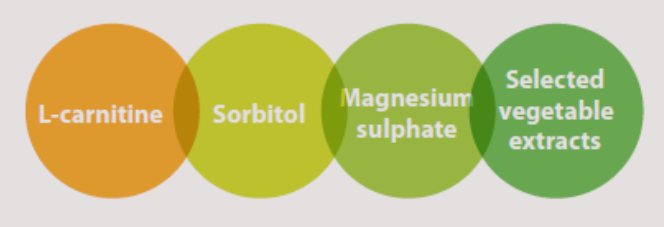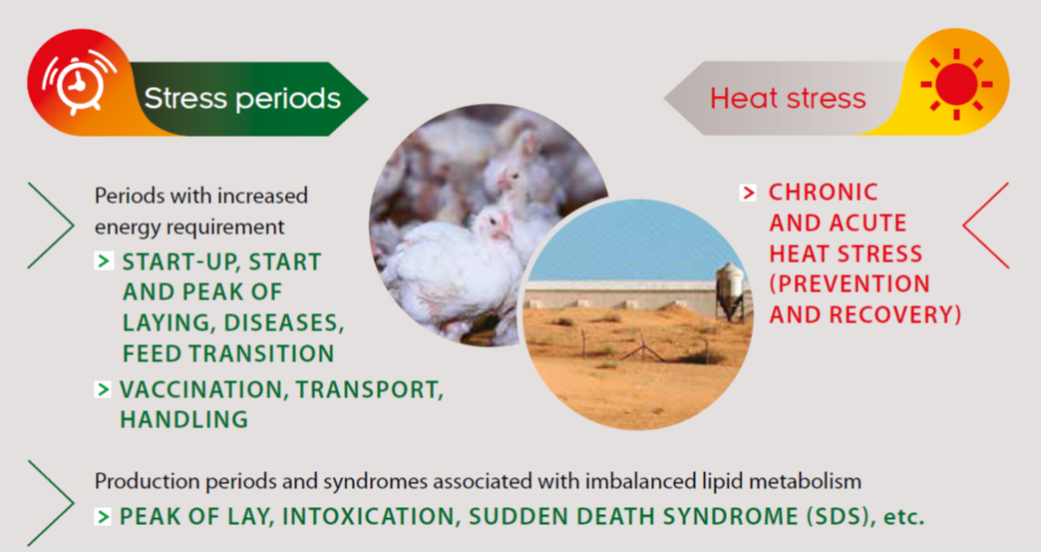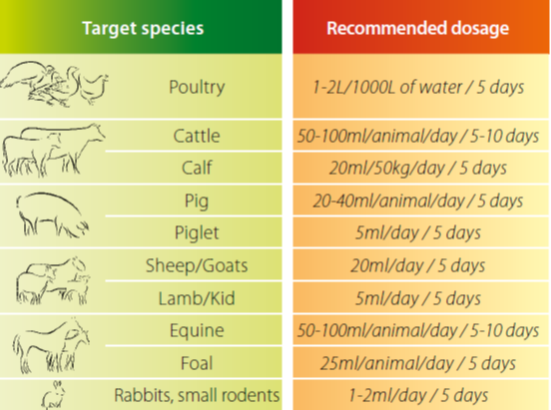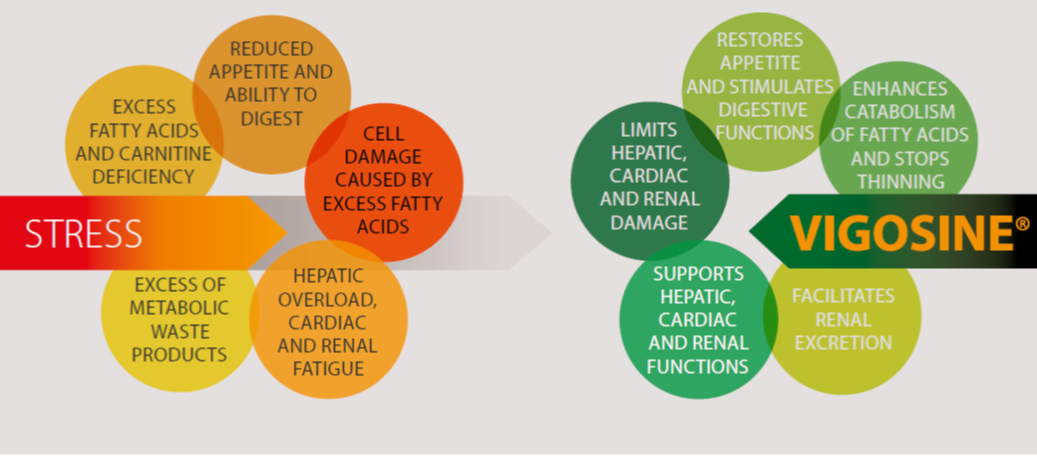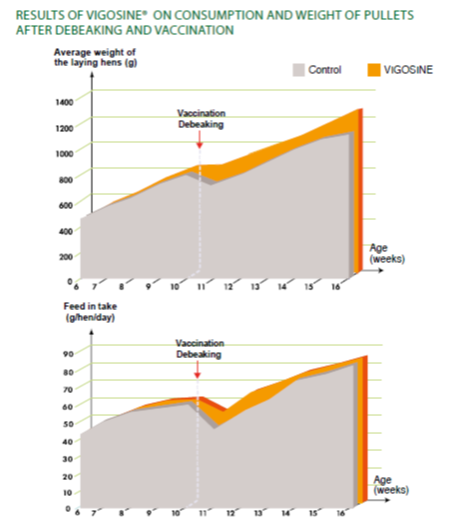What is VIGOSINE?
VIGOSINE consists of four active ingredients:
These ingredients act together in two ways:
- Optimize the efficiency of energy production from feed by improving:
2. Support detoxification and elimination of harmful waste products by improving:
What is Carnitine?
The word "carnitine" comes from "carne", latin word for "meat".
This molecule is found in large quantities in animal proteins. The L-carnitine can also be synthesized naturally from lysine and methionine. The L-carnitine plays a key role in the metabolism of fatty acids: transport into cells and mitochondria + removal of toxic metabolites.
L-carnitine usage is increased during periods of high fatty acid metabolism associated with stress related responses.
When to use VIGOSINE?
VIGOSINE can be used during critical periods of production that result in an abnormal energy usage which may affect water and feed intake and/or impair anabolic and metabolic functions.
How to use VIGOSINE?
VIGOSINE should be administered in the drinking water DURING critical periods. There is no withdrawal period for eggs or meat.
Two recommendations for poultry:
- Poultry (Layers-Breeders - Boilers) = 1-2 L/1000 L of water during 5 days
- Periods of severe or prolonged heat stress = 4 ml/bird/day for 5 days
In other Species: Cattle, Pigs, Sheep/Goats, Horse, Rabbits and Rodents, VIGOSINE can also be used at weaning, during critical growth phases and for relief of stress periods.
Why use VIGOSINE?
VIGOSINE acts as a crisis manager: where normal metabolic functions are disturbed it is able to aid impaired metabolic pathways, improve digestive functions, assist liver and kidney functions, boost energy production and waste product elimination. This results in improved physical performance in the critical periods that may adversely affect the birds health, wight again gain and feed conversion efficiency.
EXAMPLES for use
Since VIGOSINE contains only natural substances, it does not have a withdrawal time, and can be used throughout the animal's life. No side effects have been observed following administration of the product, and it is truly compatible with a large number of products. VIGOSINE is very safe to use.
Trials of VEGOSINE
- Results in PULLETS: 54,194 pullets in two houses were caught for vaccination against fowl pox, ILT and for debeaking at the same time at 10 weeks of age. In house 1, the birds were given aspirin at a dose of 0.25 g/L for 3 days after the two handlings. The birds in house 2 were given aspirin at the same dose and VIGOSINE at 2 ml/L for the 4 days following the two procedures.
This trial demonstrates that a moderate use of VIGOSINE (4 days at 2 ml/litre) enables the pullets under vaccination and debeaking stress to recover better.
- Results in BROILERS: 26,400 broilers placed in two buildings in a static-ventilation housing (initial density: 22 broilers/m2) started suffering from cardiac mortality. This trial assessed the efficacy of VIGOSINE versus a PLACEBO against this syndrome. The products were randomly assigned to the buildings and were added to the drinking water beetween 16 and 23 days of age for 7 days at 2 ml/litre.
These results show that VIGOSINE was able to reduce the percentage of affected birds with cardiac mortality while optimizing growth (body weight).
MORE EXPERIENCES
References:
- ARSLAN. C, L-carnitine and its use as a feed additive in Poultry feeding a review. Veterinary Medical Journal, 2006, 156, 3, 134-142.
- ASLAM and al. Effect of stress following vaccination against Newcastle Disease in broilers. JAPS, 2005, Vol. 15, n°34, p.56-59.
- KHALED-N-F and al. Influence of dietary L-carnitine supplementation on performance, serum traits, carcass composition and stress responses of broilers fed low-or high-fat diets Veterinary Medical Journal GIZA, 2005, vol. 53; n°2, p.577-590.
- GOSH-ASHOK and al. Stress and avian adrenal function Biomedical Research, 2002, Vol 13, n°2-3, p.60-74.
- LARBIER M., LECLERCQ B. Metabolism energetic. In: nutrition et alimentation des volailles, Editions INRA 1992, p.63-90.

 Corporate Website
Corporate Website
 Africa
Africa
 Argentina
Argentina
 Asia
Asia
 Australia
Australia
 Belgium
Belgium
 Brazil
Brazil
 Bulgaria
Bulgaria
 Canada (EN)
Canada (EN)
 Chile
Chile
 China
China
 Colombia
Colombia
 Denmark
Denmark
 Egypt
Egypt
 France
France
 Germany
Germany
 Greece
Greece
 Hungary
Hungary
 Indonesia
Indonesia
 Italia
Italia
 India
India
 Japan
Japan
 Korea
Korea
 Malaysia
Malaysia
 Mexico
Mexico
 Middle East
Middle East
 Netherlands
Netherlands
 Peru
Peru
 Philippines
Philippines
 Poland
Poland
 Portugal
Portugal
 Romania
Romania
 Russia
Russia
 South Africa
South Africa
 Spain
Spain
 Sweden
Sweden
 Thailand
Thailand
 Tunisia
Tunisia
 Turkey
Turkey
 Ukraine
Ukraine
 United Kingdom
United Kingdom
 USA
USA
 Vietnam
Vietnam

